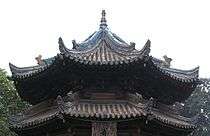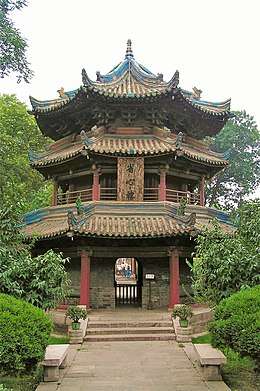Chinese Islamic architecture
The Chinese Islamic architecture or the Islamic architecture in China is a term used to indicates to the architectural heritage of the Muslims in China both of mainland or outer land of China since the earliest times to the present.
Islam has been practiced in Chinese society for 1,400 years.[3] Currently, Muslims are a minority group in China, representing between 0.45% to 1.8% of the total population according to the latest estimates.[4][5] Though Hui Muslims are the most numerous group,[6] the greatest concentration of Muslims is in Xinjiang, with a significant Uyghur population. Lesser but significant populations reside in the regions of Ningxia, Gansu and Qinghai.[7] Of China's 55 officially recognized minority peoples, ten groups are predominantly Sunni Muslim.[7]
| Part of a series on Islam in China | ||||||
|---|---|---|---|---|---|---|
 | ||||||
|
||||||
|
| ||||||
Chinese Islamic architecture in Tang period

the earliest Chinese Islamic architecture was the Great Mosque in Xian was built in 742 (according to an engraving on a stone tablet inside), and the Daxuexi Alley Mosque in Xi'an (According to the inscription of the emperor Jiajing of Ming Dynasty; the mosque was built in 705)[15][25]

Chinese Islamic architecture in Song-Liao Period
There are many examples of Islamic architecture during Song and Liao Dynasties; the Niujie Mosque in Beijing (simplified Chinese: 牛街礼拜寺; traditional Chinese: 牛街禮拜寺; pinyin: Niújiē lǐbàisì; Wade–Giles: Niu-chieh Li-pai-ssu "Oxen Street House of Worship" or Chinese: 牛街清真寺; pinyin: 'Niújiē Qīngzhēnsì'; Wade–Giles: Niu-chieh Ch'ing-chen-ssu "Oxen Street Mosque") is the oldest mosque in Beijing, China. It was first built in 996 during the Liao Dynasty and was reconstructed as well as enlarged under the Cheng Hua Emperor of the Ming dynasty who granted the mosque financial support in 1474,[25] and the Kangxi Emperor (r. 1661–1722) of the Qing Dynasty.[26] and the Huaisheng Mosque in Guangzhou.[27]
Chinese Islamic architecture in Yuan period
There are many examples of Islamic architecture during Yuan such as Beijing Dongsi Mosque (北京东四清真寺) which enlarged during Ming dynast,[25] Beijing Tongzhou Mosque ((北京通州清真寺), Quanzhou Qingjing Mosque ((泉州清净寺) which has the only example of stone entrances, Hangzhou Fenghuang Mosque (州风凰寺).[15] This period was characterized by Islamic architectural elements such as high entrances, domes, transition zones, use of bricks and stones.[28][15]
Chinese Islamic architecture in Ming period
Chinese Islamic architecture in Qing period
Gongbei
Gongbei (Chinese: 拱北; pinyin: Gǒngběi; from Arabic: قُبّة (qubba),[29] Persian: گنبد gonbad,[29] meaning "dome", "cupola"), is a term used by the Hui people in Northwest China for an Islamic shrine complex centered on a grave of a Sufi master, typically the founder of a menhuan (a Chinese Sufi sect, or a "saintly lineage"). The grave itself usually is topped with a dome.[29][30]
A similar facility is known as dargah in a number of Islamic countries.

Between 1958 and 1966, many Sufi tombs in Ningxia and throughout northwestern China in general, were destroyed, viewed by the authorities as relics of the old "feudal" order and symbols of the criticized religion, as well as for practical reasons ("wasting valuable farmland"). Once the freedom of religion became recognized once again in the 1980s, and much of the land reverted to the control of individual farmers, destroyed gongbeis were often rebuilt once again.[31]
References
- For China Family Panel Studies 2017 survey results see release #1 (archived) and release #2 (archived). The tables also contain the results of CFPS 2012 (sample 20,035) and Chinese General Social Survey (CGSS) results for 2006, 2008 and 2010 (samples ≈10.000/11,000). Also see, for comparison CFPS 2012 data in Lu 卢, Yunfeng 云峰 (2014). "卢云峰:当代中国宗教状况报告——基于CFPS(2012)调查数据" [Report on Religions in Contemporary China – Based on CFPS (2012) Survey Data] (PDF). World Religious Cultures (1). Archived from the original (PDF) on 9 August 2014. p. 13, reporting the results of the CGSS 2006, 2008, 2010 and 2011, and their average (fifth column of the first table).
- Data from: Yang Zongde, Study on Current Muslim Population in China, Jinan Muslim, 2, 2010.
- Gladney, Dru C. (2003). "The China Quarterly - Islam in China: Accommodation or Separatism? - Cambridge Journals Online". The China Quarterly. 174: 451–467. doi:10.1017/S0009443903000275.
- For China Family Panel Studies 2017 survey results see release #1 (archived) and release #2(). The tables also contain the results of CFPS 2012 (sample 20,035) and Chinese General Social Survey (CGSS) results for 2006, 2008 and 2010 (samples ≈10.000/11,000). Also see, for comparison CFPS 2012 data in Lu 卢, Yunfeng 云峰 (2014). "卢云峰:当代中国宗教状况报告——基于CFPS(2012)调查数据" [Report on Religions in Contemporary China – Based on CFPS (2012) Survey Data] (PDF). World Religious Cultures (1). Archived from the original (PDF) on 9 August 2014. Retrieved 10 July 2019. p. 13, reporting the results of the CGSS 2006, 2008, 2010 and 2011, and their average (fifth column of the first table).
- "The World Factbook". cia.gov. Archived from the original on 2016-10-13. Retrieved 2007-05-30.
- "China halts mosque demolition due to protest". Archived from the original on 2018-08-11. Retrieved 2018-08-10.
- Armijo 2006
- Dru C. Gladney, Muslim Tombs & Ethnic Folklore-Hui Identity, in The Journal of Asian Studies, California, vol.16, No.3, Aug. 1987, p. 498, p. 498 nt.8.
- Safi-ur Rahman Al-Mubarakpuri, 2009, Ar-Raheeq al-Makhtum: The Sealed Nectar: Biography of the Noble Prophet, Madinah: Islamic University of Al-Madinah al-Munawwarah, page 72: The Prophet was entrusted to Halimah...Her husband was Al-Harith bin Abdul Uzza called Abi Kabshah, from the same tribe
- Claude Philibert Dabry de Thiersant (1878). Le mahométisme en Chine et dans le Turkestan oriental (in French). Leroux.
- Maazars in China-www.aulia-e-hind.com/dargah/Intl/Chin
- BBC 2002, Origins
- Abul-Fazl Ezzati, 1994, The Spread of Islam, Tehran: Ahlul Bayt World Assembly Publications, pp. 300,303, 333.
- Hagras, Hamada (2017). "AN ANCIENT MOSQUE IN NINGBO, CHINA "HISTORICAL AND ARCHITECTURAL STUDY"". Journal of Islamic Architecture. 4(3): 102–113.
- Hamada, Hagras (2019). "XI'AN DAXUEXI ALLEY MOSQUE: HISTORICAL AND ARCHITECTURAL STUDY". Egyptian Journal of Archaeological and Restoration Studies "EJARS". 1: 97–113.
- Lipman 1997, p. 25
- Israeli, Raphael (2002). Islam in China. United States of America: Lexington Books. ISBN 0-7391-0375-X.
- Israeli (2002), pg. 291
- Muhamad S. Olimat (27 August 2015). China and Central Asia in the Post-Soviet Era: A Bilateral Approach. Lexington Books. pp. 10–. ISBN 978-1-4985-1805-5.
- Litvinsky, B. A.; Jalilov, A. H.; Kolesnikov, A. I. (1996). "The Arab Conquest". In Litvinsky, B. A. (ed.). History of civilizations of Central Asia, Volume III: The crossroads of civilizations: A.D. 250 to 750. Paris: UNESCO Publishing. pp. 449–472. ISBN 978-92-3-103211-0.
- Bosworth, C. E. (1986). "Ḳutayba b. Muslim". In Bosworth, C. E.; van Donzel, E.; Lewis, B. & Pellat, Ch. (eds.). The Encyclopaedia of Islam, New Edition, Volume V: Khe–Mahi. Leiden: E. J. Brill. pp. 541–542. ISBN 90-04-07819-3.
- Gibb, H. A. R. (1923). The Arab Conquests in Central Asia. London: The Royal Asiatic Society. pp. 48–51. OCLC 685253133.
-
- Bai, Shouyi et al. (2003). A History of Chinese Muslim (Vol.2). Beijing: Zhonghua Book Company. ISBN 7-101-02890-X., pp. 235-236
- Hagras, Hamada (2019). "Xi'an Daxuexi Alley Mosque: Historical and Architectural Study". Egyptian Journal of Archaeological and Restoration Studies "EJARS". 1: 97–113.
- Hagras, Hamada (2019-12-20). "THE MING COURT AS PATRON OF THE CHINESE ISLAMIC ARCHITECTURE: THE CASE STUDY OF THE DAXUEXI MOSQUE IN XI'AN". SHEDET (6): 134–158. doi:10.36816/shedet.006.08.
- "Restorations: Olympic Torch Or Rural Touch?". China Heritage Quarterly. Retrieved 28 October 2012.
- Hagars, Hamada (2019). "Xi'an Daxuexi Alley Mosque: Historical and Architectural Study". Egyptian Journal of Archaeological and Restoration Studies "EJARS". 1: 97–113.
- Hagras, Hamada Muhammed (2017-06-20). "An Ancient Mosque In Ningbo, China "Historical And Architectural Study"". Journal of Islamic Architecture. 4 (3): 102. doi:10.18860/jia.v4i3.3851. ISSN 2356-4644.
- Lipman, Jonathan Neaman (1998). Familiar strangers: a history of Muslims in Northwest China. Hong Kong University Press. p. 61. ISBN 962-209-468-6.
- Joseph Fletcher, The Sufi Paths (turuq) in China”, Etudes Orientales 13/14 (1994). Quoted in: Dru C. Gladney (1996). Muslim Chinese: ethnic nationalism in the People's Republic. (Volume 149 of Harvard East Asian monographs). Harvard Univ Asia Center. p. 41. ISBN 0-674-59497-5.
- Gladney, Dru C. (August 1987). "Muslim Tombs and Ethnic Folklore: Charters for Hui Identity". The Journal of Asian Studies. 46 (3): 495–532. doi:10.2307/2056897. JSTOR 2056897.
.png)